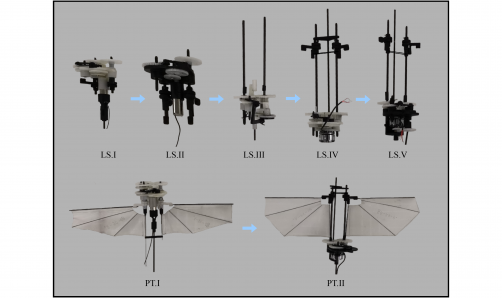Top Stories
Breakthrough in Flapping Wing Micro Air Vehicles Enhances Lift

New reports confirm a groundbreaking advancement in flapping wing micro air vehicles (FWMAVs) that could revolutionize the field of aerial robotics. Researchers from Beihang University, Tsinghua University, and the Shenzhen International Graduate School have just announced a novel lift system designed to significantly enhance aerodynamic performance while reducing power consumption.
This urgent development addresses critical limitations faced by existing FWMAVs, which struggle with controllable flight and efficient lift generation. Current models, whether powered by motors or intelligent materials, fall short of achieving the high maneuverability akin to that of hummingbirds. The new system, detailed in the study titled “Lift System Optimization for Hover-Capable Flapping Wing Micro Air Vehicle,” integrates innovative elastic energy storage elements mimicking the musculoskeletal system of hummingbirds.
The research team, led by Shengjie XIAO and Zemin WANG, has achieved a remarkable flapping angle of 154° through a combination of a crank-rocker mechanism and a sophisticated gear system. Experimental results reveal that the optimized wing, designated 80-455, made from Icarex PC31 material, boasts a wingspan of 80 mm and a chord length of 45 mm, drastically enhancing lift generation.
In a striking demonstration of performance, the new lift system can generate a stable lift of 31.98 g with a total wingspan of 175 mm and a weight of just 10.5 g. This innovation also achieved a 30.4% reduction in fuselage weight, down from 2.3 g to 1.6 g, while maintaining structural integrity and avoiding resonance issues. Furthermore, under the same lift conditions, power consumption decreased by 4.5%.
Flight tests have verified the prototype’s capabilities, allowing it to hover continuously for approximately 1 minute at 50% throttle. The vehicle also demonstrates impressive agility, performing rapid ascent maneuvers with remarkable aerodynamic efficiency and reliability.
This latest research not only pushes the boundaries of aerial technology but also holds promise for a range of applications—from environmental monitoring to search and rescue operations. The full text of the study is available at https://doi.org/10.1007/s11465-024-0790-6.
As the field of FWMAVs evolves, this breakthrough is set to capture the attention of engineers, researchers, and tech enthusiasts alike, marking a significant step towards more efficient and capable aerial vehicles. Stay tuned for further updates as this developing story unfolds.
-

 World5 days ago
World5 days agoExposing the Reality Behind Guatemala’s Garment Industry
-

 Politics5 days ago
Politics5 days agoLB Pharmaceuticals Quiet Period Ends October 21, Analysts Weigh In
-

 World5 days ago
World5 days agoHamas to Return Remains of Additional Hostage on Friday
-

 Business5 days ago
Business5 days agoRoyal Bank of Canada Upgrades Ovintiv to Outperform Rating
-

 Sports5 days ago
Sports5 days agoSaquon Barkley Reflects on James Franklin’s Dismissal from Penn State
-

 Science3 days ago
Science3 days agoYale School of the Environment Launches Accelerated Master’s Programs
-

 Lifestyle5 days ago
Lifestyle5 days agoSouth Los Angeles Intersection Renamed to Honor Activist Danny Bakewell Sr.
-

 Entertainment5 days ago
Entertainment5 days agoSylvester Stallone’s ‘Alarum’ Surges in Streaming Despite Poor Reviews
-

 Health5 days ago
Health5 days agoFDA Announces First Nine Recipients of National Priority Vouchers
-

 Science5 days ago
Science5 days agoMIT Develops 3D Brain Models from Patient Cells for Custom Therapies
-

 Entertainment5 days ago
Entertainment5 days agoOlivia Nuzzi’s Memoir Set to Uncover RFK Jr.’s Controversial Texts
-

 Lifestyle4 days ago
Lifestyle4 days agoHistorian Seeks Help to Uncover Cherry Street’s Past









